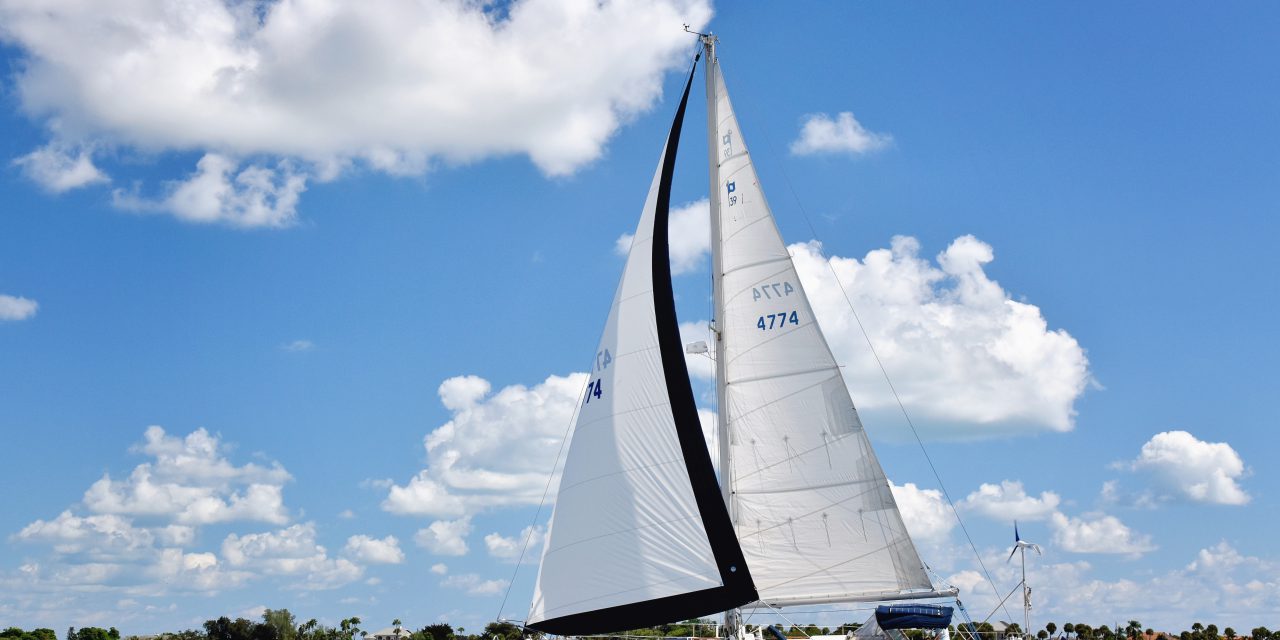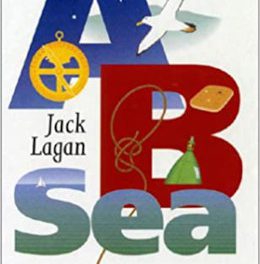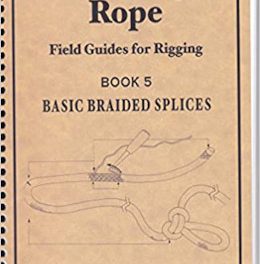A Solid CCA-Style Centerboard Racer/Cruiser
Issue 143: March/April 2022
John Geraci may not have known Pearson Yachts’ history when he learned how to sail in 1969 on a Pearson Commander, but he did know that he loved sailing the turquoise waters of Biscayne Bay south of Miami. John spent the next few years renting boats and crewing in the local racing scene until it was time to be his own skipper.

Avventura powers off the wind in Florida’s Indian River Lagoon. Bill Shaw designed the 39 with the racing skipper first in mind.
Perhaps influenced by his experience on the Commander, John purchased a 1975 Pearson 39, which he renamed Avventura, Italian for adventure. John explored south Florida and the Keys for several years before meeting his future wife, Lynda, and persuading her to sail with him. Lynda’s previous sailing experience had not gone well, but John showed her that sailing can be fun, and the pair sailed locally as well as venturing to the Bahamas.
The Geracis eventually moved to Satellite Beach, Florida, where they bought a waterfront home to dock Avventura in the

Notable deck features include a sea hood, two Dorade vents, and shrouds located outboard for a wide staying base but not-so-tight sheeting angles.
backyard. They also joined a local sailing club, East Coast Sailing Association (ECSA), and much of their sailing these days is with ECSA on weekend cruises along the Indian River Lagoon.
History
Pearson Yachts, founded by cousins Clinton and Everett Pearson in the early 1950s, was instrumental in popularizing fiberglass as a more durable alternative to wood. Clinton and Everett left the company in the mid-60s, but the Pearson brand continued with Bill Shaw as chief designer and general manager.
The company enjoyed several decades of growth, and while Pearson had a reputation for building good-quality boats, it could not escape the economic downturn of the 1980s. After changing owners several times, the company filed for bankruptcy in 1991.
The Pearson portfolio ranged from the 8-foot Plebe to the Pearson 530, with more than 50 models in between. Early models were designed by some of America’s luminaries including Phil Rhodes, Carl Alberg, and John Alden. Later models, all designed by Shaw, followed the trends of the day, from full keels to fin keels.
While time and attrition, along with limited production runs on some models, reduced the number of actively sailing Pearsons, they remain desirable sailboats. Mention that you own a Pearson, and you’ll often get a knowing nod from an old salt.
Design and Construction

Because boat speed is partly a function of waterline length, the now-defunct CCA rule, to which the Pearson 39 was designed, encouraged long overhangs; when heeled, however, waterline length increases as does boat speed.
The Pearson 39 was built from 1970 to 1978 in Portsmouth, Rhode Island, with an updated version produced from 1986 to 1991. It’s estimated that around 150 were produced, of which a dozen were yawls.
Shaw designed the Pearson 39 to be a performance boat. He wrote, “She’s the boat for the racing skipper who will occasionally cruise.” This is certainly shown in the boat’s 9-foot draft with centerboard fully lowered, a deck plan rigged for action around the buoys, and a practical interior for cruising.
Of course, much has changed since 1970; the transition from the CCA (Cruising Cub of America) rule to the IOR (International Offshore Rule), explained in Rob Mazza’s accompanying comparison (see p. 14), resulted in the trend toward fin keels, spade rudders, and lighter displacement.
The Pearson 39 hull is a solid hand-laid fiberglass laminate and is reported to be 1/2-inch thick near the keel. The centerboard trunk is molded into the 4-foot 8-inch-deep keel, which keeps the trunk below the cabin sole and provides room for a shallow bilge. Constructed from fiberglass laminate, the board is raised and lowered via a dual winch/drum assembly located in a housing aft of the galley sink, with the control line in the cockpit. One owner providing feedback felt this setup was not user friendly.
The centerboard pivots on a bronze pin embedded in the keel stub. Lead ballast is encapsulated in the forward part of the keel and extends halfway aft on both sides of the centerboard trunk.
The Pearson 39 also has a substantial rudder skeg molded as part of the hull and a bronze shoe bearing that supports the rudder.
The deck is cored with end-grain balsa wood. The hull-to-deck joint is an inward facing flange, through-bolted and glassed over, resulting in a smooth exterior deck joint. A teak toerail bolts into the flange. The Pearson 39 also has an ash wood rubrail just below the toerail to help protect the hull during docking.
Below, the cabin is finished with a textured overhead fiberglass liner bonded to the cabintop and a lower pan liner that forms the base for berths and stick-built cabinetry. The forward bulkheads fit into slots in the headliner and are glassed in place. Several owners said they had to rebed the stanchions and repair wet core underneath.
Rig
The Pearson 39 sports a masthead rig typical of the era—an aluminum keel-stepped mast with single spreaders, and fore/ aft lower shrouds attached at the spreader hounds. The lateral rigging leads to chainplates at the toerail that are bolted to fiberglass ribs molded into the interior side of the hull. The wide rigging stance makes for a strong rig but limits the headsail sheeting angle.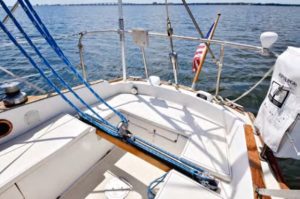
The Pearson 39 came from the factory with a hanked-on headsail, but the Geracis converted to a North Sails 135-percent jib on a Harken Mark II roller furling system. Avventura had been set up for racing by the previous owner, and much of the hardware is still in place—a mast-mounted spinnaker pole, spare blocks and winches, and an adjustable backstay.
Designed before the era of all lines leading aft to the cockpit, this boat’s main and jib are raised with dedicated winches on the mast. And, the old-fashioned boom-end main- sheet runs through a four-part tackle to the traveler mounted at the aft end of the cockpit; it’s led forward along the boom to a cabintop winch.
The full-batten mainsail has three reef points tensioned by a boom-mounted winch. Jib and spinnaker sheets lead through cars that run on toerail-mounted tracks back to the cockpit where trimmers use the three-speed primary and two-speed secondary winches mounted on the teak-capped cockpit coaming. Avventura still carries all its original Lewmar winches.
On Deck

One of the Pearson 39’s most unique features is the location of the helm near the forward end of the cockpit. Although this layout is unconventional, the open area behind the helmsperson provides good working space for sail trimmers without blocking the skipper’s view forward. The tall cockpit coamings provide good back support and keep the cockpit dry when sailing hard on the wind.
Double lifelines and teak handrails on the cabintop add a sense of security. The large, uncluttered foredeck is prob- ably the only location to store a dinghy, as the narrow stern does not lend itself to dinghy davits, which would also spoil the boat’s lines. Access to the deck from the water is by a removable midship ladder that fits on either side.
Belowdecks
The factory offered two main cabin layouts; the racing version replaced the starboard side shelves and cabinets with a pilot berth and featured a dinette to port. Several cabinetry finishes were offered.

Outboard of the sink is the top-loading icebox, which John updated with a Frigoboat 12-volt water-cooled refrigeration unit. He also replaced the alcohol stove with a Force 10 propane three-burner stovetop/oven with a flip-up cover over the stovetop to provide more counter space.
The standard layout has settees on both sides of the cabin that are long and wide enough to make comfortable berths and seat plenty of guests. Storage is good with bookshelves and cabinets above and below the settees. There is also a hanging locker that the Geracis repurposed for an AC-powered, Mermaid 16,000-Btu air-conditioning unit—necessary when tied to the dock during Florida’s hot, humid summers.
Surfaces in the head are a white laminate with some wood trim. Storage here is also good. John revamped the entire plumbing system, which included installing a Jabsco marine toilet, diverter valve, macerator pump, and 15-gallon holding tank.
Further forward, a small step leads to the forward cabin that has plenty of headroom for John’s 6-foot- plus frame; the V-berth also allows him to stretch out comfortably.
The Pearson 39 didn’t offer a finished sole, just the non-skid pan liner, and while

The forward cabin has a standard V-berth with an insert available to make it a double. Note the drawers port and starboard. On each side of the berth, long shelves can hold odds and ends that don’t fit into the portside bureau.
that may be more practical for a boat set up for racing, John and Lynda put down a non-skid rug which is easier on the feet and eyes.
Mechanicals
The Pearson 39 came standard with a Universal 30-hp gas engine, but the previous owner opted for the Westerbeke 4-107 diesel upgrade. The “Westerbeast” was showing its age, so after some research, John replaced it with a Beta 35-hp model, also replacing the V-drive and installing a dripless seal on the prop shaft. Avventura has had several different props through the years and now has a Flexofold two-blade folding prop.
Several removable panels on the engine box provide access to the engine, and additional front access is through a cockpit locker. Part of the galley cabinetry must be removed to fully expose the engine. The V-drive and propeller shaft stern tube have good access by lifting a panel on the cabin sole. A 30-gallon fuel tank under the cockpit suffices for local and coastal cruising.
The Pearson 39 came with a basic 12-volt DC system. On Avventura, the distribution panel is located just inside the companionway; it’s convenient to reach from the cockpit but is more exposed to the weather. John replaced the DC cartridge fuses with resettable circuit breakers and added panel meters to monitor the AC and DC voltages.
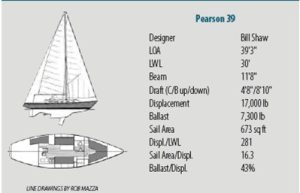 He also added a Xantrex battery charger with a built-in 2-kW inverter. In addition to the AC battery charger, twin 100-watt solar panels and the 400-watt wind generator can also charge the boat’s three AGM Group 31 batteries when the Geracis are out on a cruise.
He also added a Xantrex battery charger with a built-in 2-kW inverter. In addition to the AC battery charger, twin 100-watt solar panels and the 400-watt wind generator can also charge the boat’s three AGM Group 31 batteries when the Geracis are out on a cruise.
To help conserve energy, all the interior and navigation lights have been updated with LED bulbs. The instrument package has also been updated with Garmin depth, wind, and GPS units, and although Florida doesn’t normally have to contend with fog, Avventura also has mast-mounted radar.
Underway
The day of our test sail, a dry, cool northeasterly breeze was bringing the first hint of fall after a long, muggy, Florida summer. I met the Geracis at Dragon Point on the southern tip of Merritt Island in my dinghy so I could take underway pictures and then join them for a sail. The breeze was starting to pick up as they rounded the point and raised the sails. John trimmed in, cracked off the wind a few degrees, and Avventura took off faster than I expected for a heavier-displacement boat with a fair amount of wetted surface.
I couldn’t help but think how the graceful lines of the Pearson seemed to blend in with the bow wave as it formed its own curving line down the length of the boat. Compared to the straight lines of most modern designs, this Pearson seemed more in harmony with its element.
Then it was time for me to transfer to Avventura for a trick at the wheel. The wind was 10 to 12 knots when I took the helm. My

Avventure was repowered with a Beta diesel, again facing aft with a V-drive forward. Access from several sides is decent.
first impression was how steady and solid it felt, almost as if riding on a smooth track while also being responsive to the helm. With the wind just aft of the beam, we were averaging around 6-plus knots with just a little heel. The boat heeled a bit more in gusts but settled right back in the groove.
The Indian River Lagoon is relatively shallow for the Pearson 39’s almost 9-foot centerboard, so we sailed with it up. When John used to race Avventura, he sailed close- hauled to within 38 degrees of the wind and says the boat likes it when the wind pipes up to 15-plus knots. Other owners agree the Pearson 39 sails well on all points of sail, even with the board up, but it can start to crab when the wind picks up on a close reach.
Conclusion
If you ask owners what they like the most about their older Pearsons, they’ll often say they fell in love with their boat’s lines and its sailing performance. The Geracis are no exception.
Pearson built above-average boats that sail well, but like any sailboat approaching 50 years, expect some level of refitting and updating. An Internet search showed a handful of Pearson 39s for sale along the East Coast with prices ranging from $25,000 for one needing a refit, to close to $40,000 for an updated model. Finding documentation on older Pearsons can be a challenge, but there are several Internet groups that can be a helpful source of information. Start with pearsonyachts.org.
Joe Cloidt is a retired electrical engineer who lives and sails on Florida’s east central coast. When he isn’t out cruising on his Pearson 31 or racing on a J/30 at the local yacht club, he can often be found in his shop tinkering on his latest project or simply messing about in boats.
Thank you to Sailrite Enterprises, Inc., for providing free access to back issues of Good Old Boat through intellectual property rights. Sailrite.com

